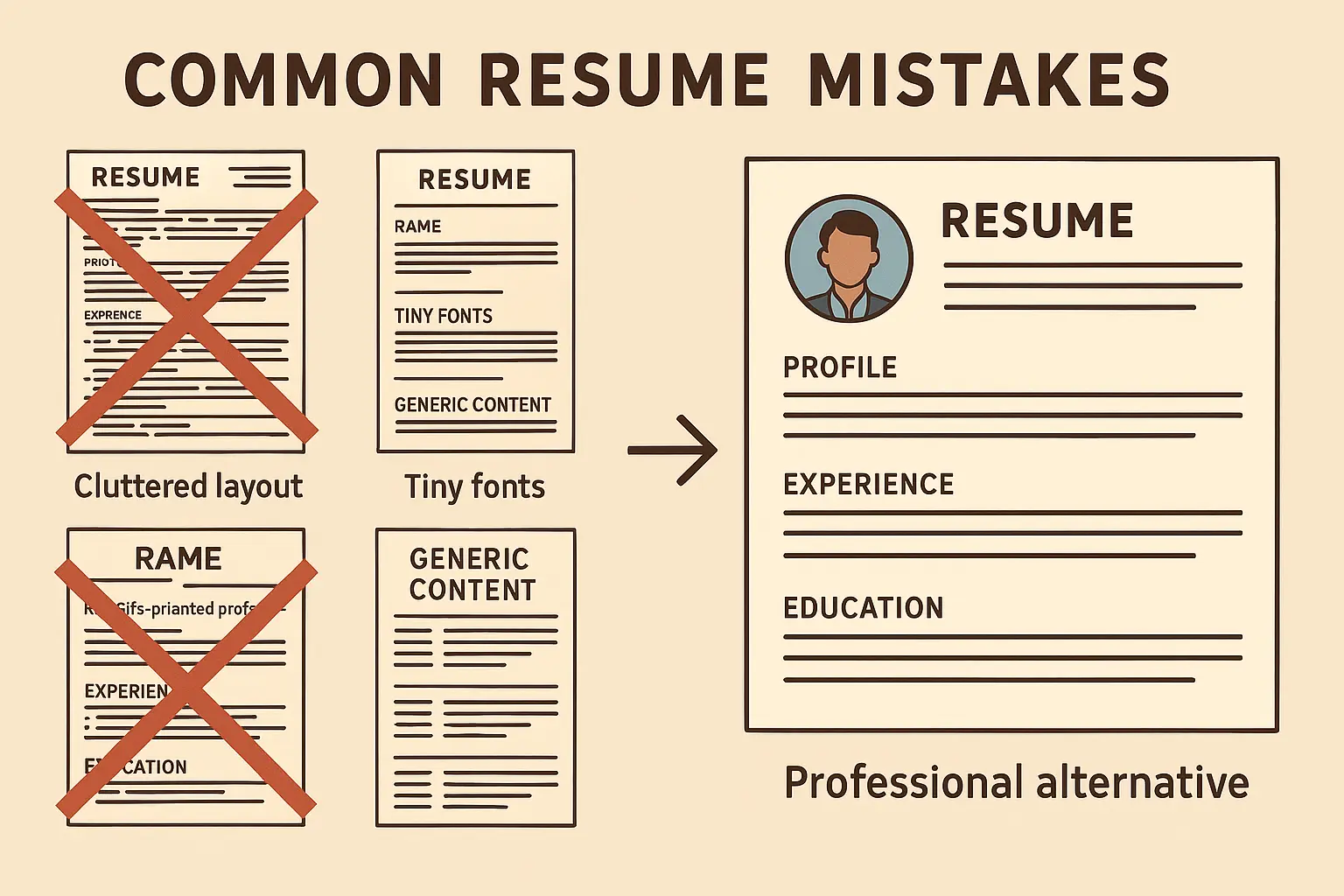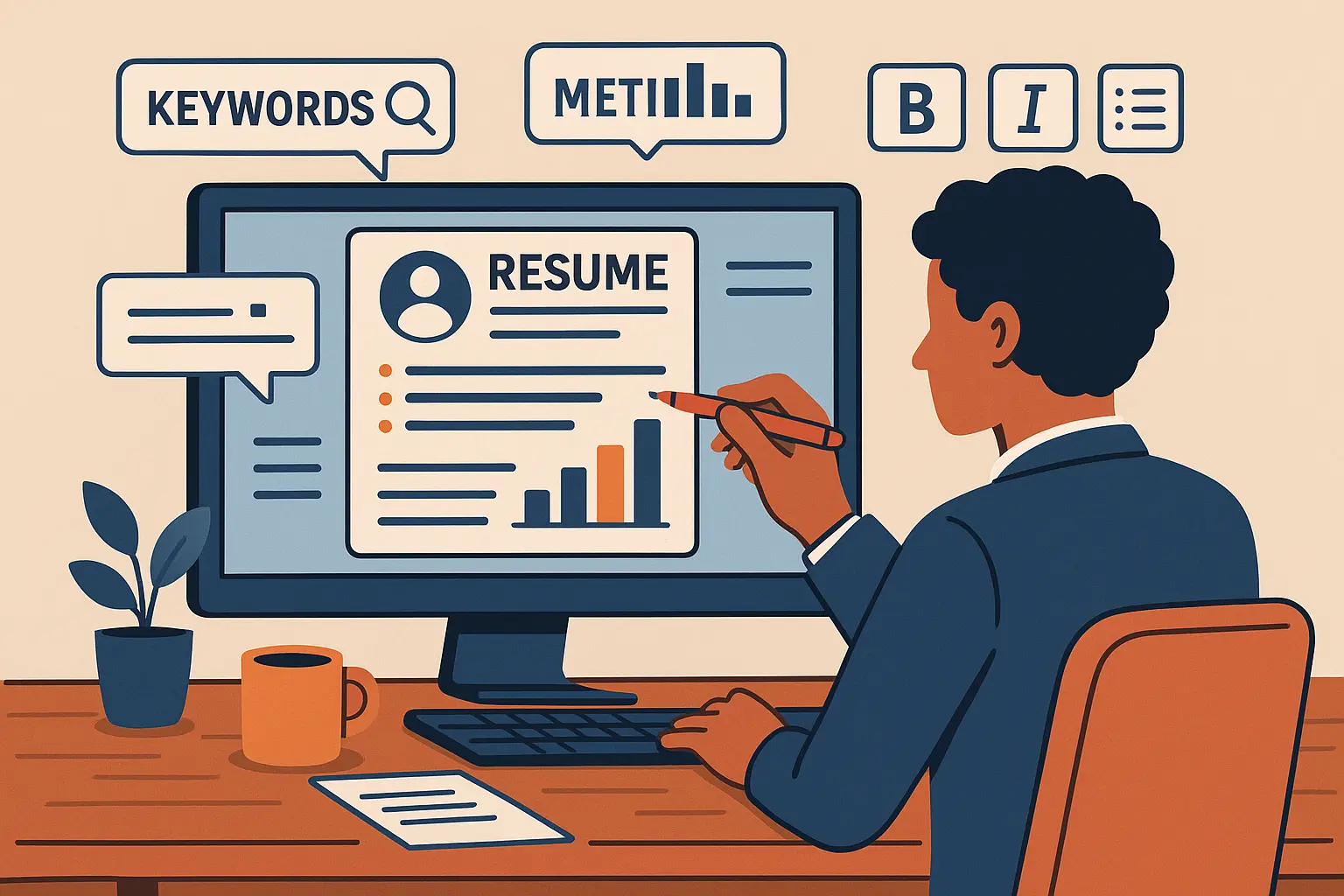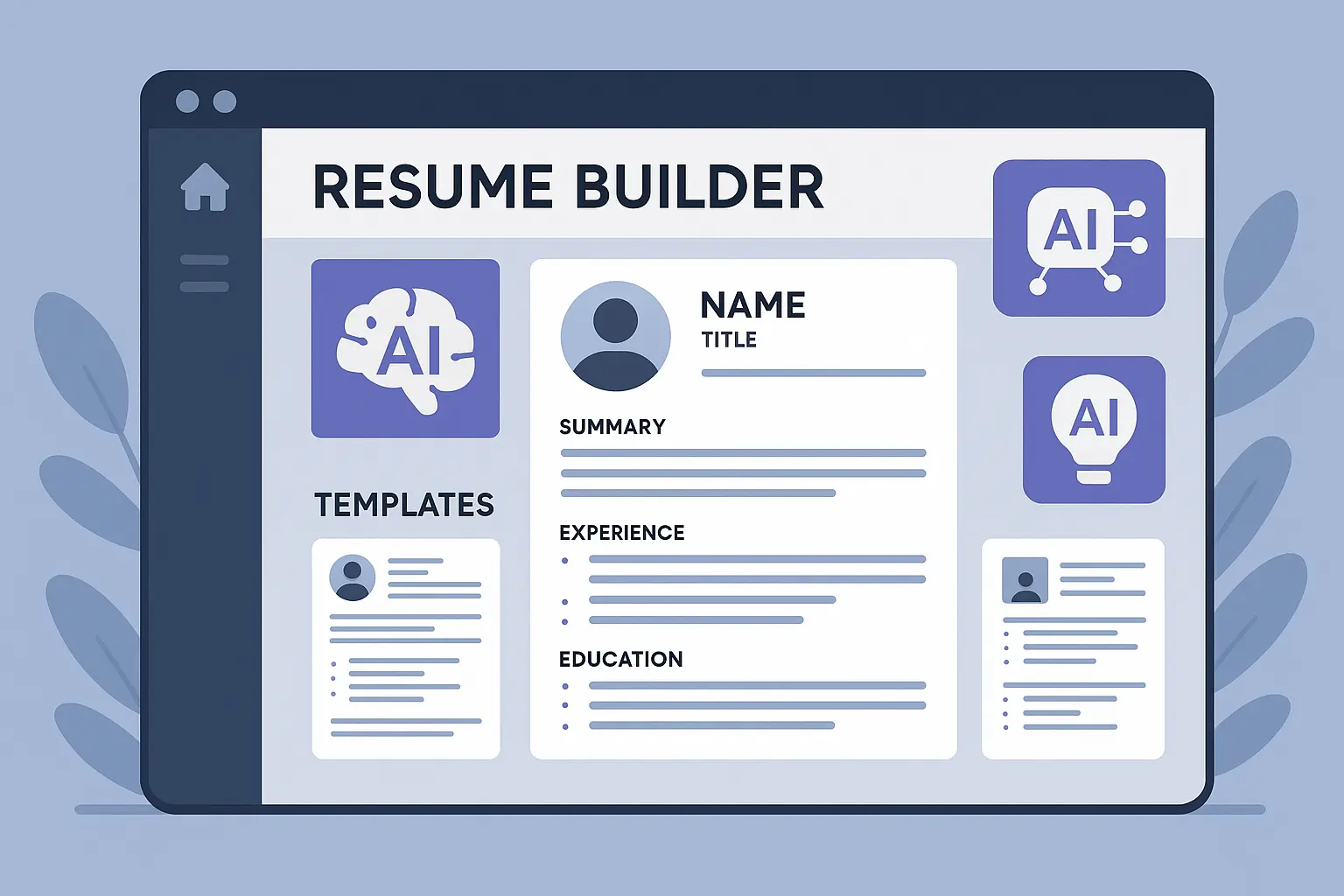25 Basic Resume Examples That Actually Get You Hired (Plus Expert Analysis)

Here’s something that’ll blow your mind – 3 out of 4 resumes get rejected before a human even sees them. I learned this the hard way when I spent weeks crafting what I thought was the perfect resume, only to hear nothing back from dozens of applications. That statistic from Hloom’s resume statistics research hit me like a wake-up call – it wasn’t just about having experience, it was about presenting it correctly.
I remember staring at my laptop at 2 AM, wondering why I wasn’t hearing back from jobs I was clearly qualified for. Turns out, my resume was getting stuck in digital purgatory. After diving deep into resume optimization and studying hundreds of successful applications, I’ve compiled 25 basic resume examples that consistently perform well across different industries and career levels.
Look, these aren’t your typical cookie-cutter templates you find everywhere online. These are strategic frameworks that address the real challenges you’re dealing with when trying to stand out in a crowded job market. Whether you’re a recent graduate stressing about your “limited” experience or a seasoned professional looking to make a career transition, you’ll find examples here that speak directly to your situation.
Table of Contents
- Understanding What Makes Resume Examples Effective
- Entry-Level Resume Examples (Examples 1-5)
- Mid-Career Professional Resume Examples (Examples 6-11)
- Senior-Level and Executive Resume Examples (Examples 12-16)
- Industry-Specific Resume Examples (Examples 17-21)
- Specialized Situation Resume Examples (Examples 22-25)
- How to Choose the Right Resume Example for Your Situation
- Common Mistakes to Avoid When Using Resume Templates
- Optimizing Your Chosen Resume Example for Maximum Impact
- Transform Your Resume with Professional Tools
TL;DR
- Pick resume examples based on your actual career stage and industry – not just what looks pretty
- Entry-level folks should focus on potential and education, not trying to inflate limited experience
- Mid-career professionals need to let their quantified achievements do the talking
- Senior-level examples must show strategic thinking and measurable business impact
- Industry-specific examples aren’t optional – they’re essential for speaking the right professional language
- Here’s the deal: if your resume can’t get past the robots, it doesn’t matter how impressive you are
- Career changers and people returning to work need targeted approaches that address concerns head-on
- Every bullet point should have numbers if possible – “increased by 25%” beats “improved performance”
- One-size-fits-all resumes get one-size-fits-all results (which is usually rejection)
- Professional resume builders can handle the technical stuff while you focus on your story
Understanding What Makes Resume Examples Effective
Look, here’s the thing about effective resumes – they’re not just about looking pretty on your screen. They’re like your professional wingman, designed to get you past all the digital gatekeepers and actually land on a real person’s desk.
I’ve seen way too many people obsess over fancy fonts and creative layouts, only to wonder why they’re not getting calls back. The truth is, there are five things that actually matter when it comes to whether your resume works or just collects digital dust.
Understanding the fundamentals of professional resume format becomes crucial when you’re trying to figure out which basic resume examples will actually work for your career goals instead of just looking impressive on Pinterest.
| Resume Effectiveness Factor | Why It Matters | Impact on Hiring Success |
|---|---|---|
| ATS Compatibility | 75% of resumes are screened by ATS systems before human review | High – Determines if resume reaches hiring managers |
| Industry Relevance | Hiring managers expect field-specific terminology and format | Medium-High – Shows cultural fit and expertise |
| Career Stage Appropriateness | Format must match experience level and career goals | High – Prevents over/under-qualification perception |
| Content Quality & Structure | Quantified achievements vs. generic job descriptions | Very High – Differentiates candidates with similar backgrounds |
| Modern Design Standards | Clean, mobile-friendly formatting for digital review | Medium – Ensures professional presentation across devices |
ATS compatibility is your biggest hurdle – and I mean BIGGEST. Think about it this way: if a robot can’t read your resume, a human never will. These systems are pickier than your grandmother about table manners. They want clean formatting, standard headings like “Experience” (not “My Professional Journey”), and fonts they recognize. Skip the fancy graphics – they just confuse the machines.
For comprehensive guidance on creating ATS-friendly resume documents that successfully navigate automated screening systems, you’ll want to understand the specific formatting requirements that actually get you past these digital bouncers.
Industry relevance is where a lot of people mess up. You wouldn’t wear flip-flops to a banking interview, right? Same logic applies here. If you’re going after a corporate finance job, your resume better look buttoned-up and conservative. Creative fields? You’ve got a little more wiggle room, but don’t go overboard.
Traditional industries like banking and law want to see stability and progression in conservative formats. Tech roles care more about what you’ve built and the impact you’ve had. Healthcare positions need those certifications front and center because they’re literally required to do the job.
Career stage appropriateness means being honest about where you are. I’ve seen new grads try to make their summer internship sound like they ran the company. Don’t do that. Own your level and show your potential instead. Entry-level examples should focus on education and transferable skills rather than trying to inflate limited experience. Mid-career examples need to emphasize achievements and career progression with real numbers. Senior-level examples must highlight leadership experience and strategic impact on the whole organization.
Content quality and structure separate the winners from the “thanks, but no thanks” pile. The most effective examples show quantified achievements instead of boring job duty lists, action-oriented language that proves you take initiative, relevant keywords that flow naturally (not stuffed in awkwardly), logical flow that tells your career story, and appropriate length that respects hiring managers’ time.
Here’s what really matters: quantified achievements. Instead of saying you “managed social media,” tell them you “boosted Instagram engagement by 150% and brought in 50 new customers last quarter.” Numbers don’t lie, and hiring managers love them.
Modern design standards aren’t about being trendy – they’re about meeting current expectations. Clean, minimalist designs that look good on phones and tablets, smart use of white space so your resume isn’t cramped, professional colors that enhance rather than distract, mobile-friendly formatting for recruiters scrolling on their phones, and consistent fonts that don’t make your resume look like a ransom note.
Entry-Level Resume Examples (Examples 1-5)
Starting out in your career feels like trying to get experience to get a job to get experience – it’s maddening. But here’s what I’ve learned: employers hiring entry-level folks aren’t expecting you to have run a Fortune 500 company. They want to see that you’re coachable, reliable, and have some transferable skills.
That’s why entry-level basic resume examples are designed to highlight potential, transferable skills, and education without overinflating experience.
1. Recent College Graduate Resume
Fresh out of college? Your degree is your superpower right now. Lead with it. If you graduated with honors or had a decent GPA (3.5 or higher), put it on there. Don’t be shy about that capstone project that actually impressed your professor – it shows you can deliver real results.
The structure flows from contact information to a brief professional summary (keep it to 2-3 lines max), then education with relevant coursework and honors, experience covering internships and part-time work, skills highlighting both technical and soft abilities, and activities or volunteer work that rounds out your profile.
Sarah’s Success Story: Sarah was stressing about her “limited” experience until she realized her senior marketing project wasn’t just schoolwork – it was a real campaign that got real results. She positioned her capstone project (a comprehensive marketing campaign for a local business that increased their social media engagement by 60%) as her primary achievement, followed by her internship where she assisted with three product launches. By treating her academic work like the professional experience it actually was, she landed her first corporate role.
The trick is treating your academic work like the professional experience it actually was. That group project where you kept everyone organized? That’s project management. The presentation that got the whole class engaged? That’s communication skills. This format works because it acknowledges your current career stage while positioning your academic achievements as stepping stones to professional success.
2. Career Starter with Some Experience
You’ve got a foot in the door somewhere – maybe a year or two under your belt. This is actually a sweet spot because you can show growth without the pressure of being a seasoned pro.
This combination format balances your developing skills with actual work experience, creating a compelling story of growth and potential. Focus on what you’ve learned and how you’ve improved. Did you go from needing supervision to training the new person? That’s leadership development. Did your responsibilities expand? That shows your boss trusts you with more important stuff.
Key focus areas include showing you can learn quickly, demonstrating growth through increasing responsibilities, and highlighting achievements that prove you can deliver results even with limited experience. The combination format lets you lead with your strongest points while still providing the work history employers expect.
3. High School Graduate Resume
Going straight from high school to the workforce? Don’t let anyone make you feel like that’s not valid. You’ve got work ethic, and that counts for a lot.
This skills-based format maximizes every experience to show you’re ready for professional responsibilities. Your part-time job at the coffee shop taught you customer service under pressure. That volunteer work? You showed up when you didn’t have to. Your good grades prove you can learn and meet deadlines. These are exactly the things employers want to see.
The template highlights academic achievements like honor roll or relevant coursework, extracurricular activities showing leadership or teamwork, part-time work including retail or food service experience, and volunteer work demonstrating community involvement. The focus stays on soft skills like reliability and willingness to learn, work ethic shown through balancing school and employment, and potential demonstrated through academic performance.
4. Trade School Graduate Resume
Trade school grads have something a lot of college graduates don’t – hands-on skills that employers can use immediately. Your certifications aren’t just pieces of paper; they’re proof you know how to do the actual work.
This format emphasizes technical certifications prominently, hands-on training showing practical application, apprenticeships or internships in your trade, safety certifications proving professional responsibility, and specialized equipment experience that sets you apart.
Safety certifications are gold in trade industries. Zero accidents during training? Put that front and center. Employers care more about whether you can do the job safely than whether you can write a perfect essay. The emphasis falls on technical competencies employers can use immediately, safety knowledge showing you understand workplace requirements, and practical experience proving you can apply your training.
5. Military Transition Resume
Making the jump from military to civilian work can feel like learning a new language. The good news? You’ve got discipline, leadership experience, and technical training that most people your age don’t have.
This functional format focuses on translating military skills into civilian applications while highlighting leadership, technical training, and security qualifications that make veterans valuable employees. The challenge is translating military speak into civilian terms. Instead of “managed logistics for 50-person unit,” try “coordinated supply chain operations for team of 50, ensuring 100% on-time delivery.” Same skills, different words.
The format emphasizes security clearances providing immediate value, leadership roles demonstrating management abilities, technical training translating to civilian applications, and discipline instilled by military service. This approach helps hiring managers understand how your military experience applies to their needs while addressing concerns about cultural fit.
Mid-Career Professional Resume Examples (Examples 6-11)
You’re in the sweet spot now – you’ve got real experience to show off, but you’re not so senior that people expect you to have revolutionized entire industries. This is where you can really let your track record do the talking with basic resume examples tailored to mid-career professionals.
| Mid-Career Resume Section | Primary Focus | Key Metrics to Include |
|---|---|---|
| Professional Summary | Career trajectory and core competencies | Years of experience, key achievements, specializations |
| Experience | Quantified achievements and progression | Revenue impact, team size, budget responsibility, efficiency gains |
| Skills | Technical and leadership capabilities | Software proficiency, certifications, management experience |
| Education | Relevant degrees and ongoing development | Degree type, continuing education, professional development |
| Additional Sections | Industry involvement and recognition | Professional associations, awards, publications, speaking engagements |
6. Project Manager Resume
Project management is all about results, so your resume better be packed with them. Don’t just say you “led projects” – tell them you “delivered $2.5M software rollout three weeks early and 8% under budget while managing a cross-functional team of 15.”
The format highlights PMP certification or other credentials, project outcomes with specific metrics like budget and timeline performance, team leadership with details about scope, and measurable results showing organizational impact. Sample achievements might include “Led cross-functional team of 15 to deliver $2.5M software implementation 3 weeks ahead of schedule and 8% under budget.”
PMP certification? Put it right up top. It shows you’re serious about the profession and you’ve got the knowledge to back up your experience. This approach works across industries because project management principles stay consistent while allowing for industry-specific customization.
7. Sales Professional Resume
Sales resumes are the easiest to write because everything’s about numbers. Exceeded quota? By how much and for how long? Grew your territory? From what to what? Retained clients? What percentage?
If you’re in sales and your resume doesn’t have numbers all over it, you’re doing it wrong. Hiring managers want to see that you can hit targets consistently, not just once in a blue moon. Key elements include quota achievements with specific percentages, revenue growth figures showing company contribution, client relationship metrics like retention rates, and territory expansion results demonstrating business development skills.
For sales professionals seeking specialized guidance, exploring top sales resume builders can provide industry-specific templates that emphasize the metrics and performance achievements that sales managers actually care about.
The quantified results section might show “Exceeded annual quota by 125% for 8 consecutive years” or “Grew territory from $3M to $8M annual revenue in 3 years.” This format works across all sales environments because it focuses on universal sales metrics while allowing for industry-specific customization.
8. Marketing Specialist Resume
Modern marketing is part creative, part data scientist. James figured this out when he stopped focusing just on the pretty campaigns and started talking about the leads and revenue they generated.
James’s Success Story: James was struggling to transition from a small agency to a Fortune 500 company until he repositioned his approach. He highlighted his most successful campaign first: a social media initiative that generated 2,400 qualified leads and $1.2M in attributed revenue over six months. That social media campaign that “performed well”? How well? 2,400 leads and $1.2M in revenue is a lot more impressive than “increased engagement.” By quantifying every campaign result and showcasing his proficiency with marketing tools, he demonstrated both creative and technical capabilities that larger companies needed.
The template highlights campaign performance with metrics like lead generation and ROI, digital marketing skills including SEO and analytics, brand management experience showing strategic thinking, and measurable impact through specific numbers. Examples might include “Increased organic website traffic by 180% through SEO strategies” or “Generated $2.3M in marketing qualified leads.”
This approach works well because it shows both the creative and analytical sides of modern marketing while providing concrete evidence of your ability to drive business results.
9. Administrative Professional Resume
Admin work often gets undervalued, but good admins keep entire organizations running smoothly. The trick is showing the impact of your behind-the-scenes work.
This format emphasizes skills and achievements showing how you make organizations run smoother. That new filing system you implemented? It didn’t just organize papers – it cut document retrieval time by 40%, making everyone more productive. That’s the kind of efficiency improvement executives love to see.
Key elements include software proficiency in business applications, process improvements saving time or money, executive support enhancing productivity, and operational efficiency benefiting the entire organization. Examples might include “Implemented new filing system reducing document retrieval time by 40%” or “Managed executive calendar and travel for C-suite team of 5.”
10. Healthcare Professional Resume
Healthcare is all about credentials, compliance, and patient outcomes. Your licenses and certifications need to be prominent because they’re literally required to do the job.
But don’t forget the human side – patient satisfaction scores, successful treatment outcomes, and your commitment to ongoing education show you care about providing quality care, not just checking boxes. The format prominently displays licenses and certifications, patient care outcomes and satisfaction metrics, continuing education showing commitment to staying current, compliance knowledge including HIPAA and regulatory requirements, and specialization areas that set you apart. Examples might include “Maintained 98% patient satisfaction rating while managing caseload of 50+ patients” or “Achieved zero compliance violations during 3-year tenure.”
This approach works across healthcare settings because it addresses universal healthcare employment requirements while allowing for specialization in clinical care, healthcare administration, or specialized medical fields.
11. Information Technology Specialist Resume
IT folks need to speak two languages: technical and business. Yes, you need to show you can code or manage systems, but you also need to show how that technical work helped the company save money or work more efficiently.
“Migrated systems to the cloud” is technical. “Migrated to cloud infrastructure, reducing IT costs by 30% while improving system uptime to 99.9%” is a business result that executives understand and value.
Key elements include programming languages and technical skills relevant to your specialization, system implementations and infrastructure projects, security protocols and compliance experience, and innovation achievements like automation or optimization. Examples might include “Implemented cloud migration reducing infrastructure costs by 30%” or “Developed automated testing framework improving deployment efficiency by 50%.”
This format works well because it speaks to both technical hiring managers who need to verify your skills and business leaders who need to understand your impact on organizational objectives.
Senior-Level and Executive Resume Examples (Examples 12-16)
At this level, you’re not just doing the work – you’re shaping strategy and leading organizations. Your resume needs to show you can think beyond your department and drive results that matter to the whole company.
12. Senior Manager Resume
Senior managers are the bridge between the C-suite’s big ideas and the teams that make them happen. You need to show you can translate strategy into action and get results through other people.
Leading a team of 5 is different from leading a team of 50. Managing a $100K budget is different from managing $10M. Be specific about the scale of your responsibility because it shows progression and capability.
The template highlights team leadership with specific details about team size and scope, strategic initiatives showing ability to think beyond daily operations, financial responsibility including budget management and P&L accountability, and organizational impact through measurable improvements. Key elements include executive presence through board presentations, change leadership during transformations, multi-department oversight showing broad understanding, and strategic planning demonstrating forward-thinking capabilities.
13. Director Level Resume
Directors operate in that sweet spot where you’re still close enough to operations to understand what’s really happening, but senior enough to influence company direction. This is where transformation stories really shine.
“Led digital transformation” is vague. “Led digital transformation initiative that eliminated $12M in annual costs while improving customer satisfaction scores by 30%” shows you can drive change that actually matters.
The structure showcases organizational transformation through major change initiatives, revenue growth with specific dollar amounts and percentages, market expansion including new territories or segments, and leadership scale with details about team sizes and budgets. Business impact metrics might include “Led digital transformation initiative resulting in $12M cost savings and 30% improvement in operational efficiency.”
14. C-Suite Executive Resume
C-suite resumes are read by boards of directors and investors – people who care about shareholder value, market position, and long-term strategy. Every line should demonstrate your impact on the company’s overall success.
Your achievements should be tied to stock price, market share, revenue growth, or other metrics that board members track. This isn’t the place for modest understatement – if you grew the company, say so with numbers.
Key elements include corporate governance experience with public companies, shareholder value creation through stock performance and market growth, industry leadership through thought leadership and positioning, and board experience including fiduciary responsibilities. The executive summary becomes particularly powerful, providing compelling opening statements with quantified achievements that immediately establish executive credentials.
15. Non-Profit Executive Resume
Non-profit leadership requires a different approach that balances mission-driven achievements with business acumen. You need to show both mission impact and financial stewardship because boards want leaders who can advance the mission while running a tight financial ship.
Maria’s Success Story: Maria transformed a struggling community health organization by securing $3.2M in federal grants over two years while expanding services to reach 40% more families in underserved areas. She didn’t just raise money – she showed how that funding translated into real community impact. Her resume emphasized measurable community outcomes alongside financial stewardship, showing how she increased program efficiency by 35% while maintaining 95% client satisfaction scores.
The template highlights grant acquisition with specific amounts and success rates, program development showing ability to create social impact initiatives, community impact through beneficiaries served and outcomes achieved, and stakeholder management including donor relations and community partnerships. Unique metrics include funds raised, programs launched and their reach, beneficiaries served with outcome measurements, and community partnerships that amplify impact.
16. Consultant/Freelancer Resume
Independent consultants face a unique challenge: how do you present diverse client work as a coherent professional story? The answer is focusing on results and expertise rather than chronological job history.
Your value proposition is solving problems and delivering outcomes across different situations. Show the variety of challenges you’ve tackled and the consistent results you’ve achieved. The structure emphasizes client results with specific outcomes and ROI measurements, industry expertise showing deep knowledge, thought leadership through speaking and publications, and diverse project experience demonstrating adaptability.
The portfolio approach allows you to highlight multiple client successes without getting lost in chronological details. Examples might include “Delivered 25% cost reduction for Fortune 500 manufacturing client through process optimization” or “Led digital transformation for mid-market retailer resulting in 40% increase in online revenue.”
Industry-Specific Resume Examples (Examples 17-21)
Different industries have their own languages, expectations, and deal-breakers. What works in tech might bomb in healthcare, and what’s perfect for finance could seem stuffy in creative fields. The right basic resume examples can help you match your skills to industry-specific expectations and terminology.
17. Education Professional Resume
Education is all about student outcomes and continuous learning. Your teaching certifications matter, but so does evidence that your students actually learned something.
Test score improvements, graduation rate increases, successful program launches – these show you’re not just teaching, you’re making a difference in students’ lives and institutional success. Key elements include teaching certifications and administrative licenses, student achievement data showing learning impact, curriculum development demonstrating instructional leadership, and educational technology integration showing modern capabilities.
For educators seeking specialized guidance, teacher resume examples provide targeted templates that emphasize classroom achievements, student outcomes, and educational credentials that school administrators actually prioritize.
Educational impact metrics might include “Increased graduation rate from 82% to 91% over 4-year period” or “Implemented data-driven instruction model resulting in 25% improvement in standardized test scores.” The format also emphasizes community partnerships, grant writing success, and leadership roles extending beyond the classroom.
18. Creative Professional Resume
Creative professionals walk a tightrope between artistic vision and business results. Your resume needs to show both sides – the creative awards and recognition, plus the campaigns that drove sales or brand awareness.
The design should reflect your aesthetic sense without going overboard. Remember, it still needs to get past ATS systems, so keep the fancy graphics to a minimum. The template highlights award recognition from industry organizations, client work with specific campaign results, creative process expertise showing strategic thinking, and portfolio integration providing visual evidence.
Metrics focus on campaign performance including audience engagement and business results. Examples might include “Created award-winning campaign for consumer goods client resulting in 40% sales increase” or “Developed brand identity for tech startup that secured $15M Series A funding.” The format works across creative disciplines while allowing for specialization in graphic design, advertising, or digital marketing.
19. Legal Professional Resume
Legal resumes are conservative by nature, and for good reason. This is a profession built on precision, ethics, and proven results. Your bar certifications go at the top, followed by your track record of successful outcomes.
Case wins, settlement values, successful negotiations – these are the metrics that matter in legal work. Just make sure you’re not violating any confidentiality agreements when you quantify your achievements. Key elements include bar certifications prominently displayed, case outcomes with specific results and settlement values, legal specializations showing expertise areas, and professional standards including ethical compliance.
Achievement focus includes case wins, settlement values, client satisfaction, and successful legal strategies. Examples might include “Achieved favorable outcomes in 85% of litigation cases” or “Negotiated settlements totaling $2.3M for personal injury clients.” The format maintains the conservative, professional appearance that legal employers expect.
20. Financial Services Resume
Financial services is heavily regulated, so compliance is huge. A clean regulatory record is just as important as strong performance numbers. Your Series licenses, CFA, or other certifications prove you’re qualified to handle people’s money.
Financial professionals can benefit from specialized finance resume builders that understand regulatory requirements, compliance standards, and performance metrics specific to banking, investment, and financial planning roles.
| Financial Services Resume Component | Required Elements | Success Metrics |
|---|---|---|
| Licenses & Certifications | Series 7, 66, CFA, CFP, etc. | License acquisition dates, continuing education |
| Compliance Record | Zero violations, audit results | Years of clean compliance, regulatory knowledge |
| Client Portfolio Performance | AUM growth, client retention | Portfolio value, retention rates, new client acquisition |
| Revenue Generation | Fee income, commission targets | Annual revenue, quota achievement, growth percentages |
| Risk Management | Investment strategies, risk assessment | Portfolio performance vs. benchmarks, risk-adjusted returns |
Client portfolio growth, asset retention, revenue generation – these numbers tell the story of your success in managing and growing financial assets. Quantified performance might include “Grew assets under management from $15M to $45M over 3-year period” or “Maintained 98% client retention rate while achieving 15% annual portfolio growth.”
21. Engineering Professional Resume
Engineers solve problems and build things, so your resume should emphasize both technical expertise and practical results. Safety records are crucial – zero incidents isn’t just a nice-to-have, it’s essential.
Engineers seeking comprehensive guidance can explore complete guide top engineering resume builders for specialized templates that emphasize technical skills, project outcomes, and industry-specific certifications.
Cost savings, efficiency improvements, successful project completions – these show you can apply your technical knowledge to create real business value. Key elements include professional engineering license and certifications, project specifications with scope and budget details, technical innovations showing problem-solving capabilities, and safety achievements including zero-incident records.
Project impact focuses on cost savings, efficiency improvements, and safety enhancements. Examples might include “Led $3M facility expansion project with zero safety incidents and 5% under budget completion” or “Designed process improvement reducing manufacturing waste by 35% and saving $500K annually.”
Specialized Situation Resume Examples (Examples 22-25)
Not everyone follows the traditional career path, and that’s totally okay. These situations require special strategies to address potential concerns while highlighting your unique strengths.
22. Career Change Resume
Career changers need to build a bridge between their past experience and future goals. The key is showing how your previous skills apply to your new direction while demonstrating genuine commitment to the change.
Don’t just say you want to change careers – show you’ve done the homework. Relevant courses, networking activities, volunteer work in your target field – these prove you’re serious about the transition. The structure highlights transferable achievements applying to your target field, relevant training including courses and certifications, industry research showing understanding of your new field, and clear transition strategy explaining your rationale.
Skill translation becomes crucial, showing how previous experience applies to your target role. Examples might include “Leveraged project management skills from construction industry to lead software implementation initiatives” or “Applied customer service expertise from retail to client relationship management in professional services.”
23. Return-to-Work Resume
Taking time off doesn’t erase your skills, but you need to show you’ve kept them current. Volunteer work, freelance projects, professional development – these activities prove you’ve stayed engaged with your field.
Address the gap honestly but briefly, then focus on what you’ve maintained and learned during your time away. Confidence is key here. Key elements include maintained skills through freelance or consulting work, volunteer work keeping you engaged professionally, professional development including courses and certifications, and current industry knowledge showing you’ve stayed informed.
Examples might include “Maintained marketing skills through pro bono work for 3 non-profit organizations” or “Completed Google Analytics certification and HubSpot content marketing program during career break.” The format highlights networking activities and industry involvement showing continued professional connection.
24. Remote Work Focused Resume
Remote work requires specific skills that not everyone has. Self-management, digital collaboration, virtual leadership – these aren’t just nice-to-haves anymore, they’re essential skills in many roles.
Show specific examples of managing distributed teams, leading virtual projects, or achieving results without face-to-face supervision. These prove you can thrive in remote environments. The template highlights remote work experience with distributed team management details, digital collaboration tools and platforms mastered, self-management skills including time management and independent work, and virtual leadership including remote team management.
Virtual leadership examples might include “Managed remote marketing team of 8 professionals across 5 time zones” or “Conducted weekly video standups and monthly virtual team building activities for distributed team of 25.” The format emphasizes results achieved in remote environments, showing you can deliver outcomes regardless of physical location.
25. Gig Economy Professional Resume
Gig workers often have incredibly diverse experience, but presenting it coherently can be challenging. Focus on the common threads – client satisfaction, adaptability, entrepreneurial success.
The variety of your experience is actually a strength. It shows you can adapt quickly, work with different types of clients, and deliver results across various situations. Key elements include multiple client relationships with specific project outcomes, project variety showing adaptability and broad skill sets, self-employment success including business development and retention, and entrepreneurial skills including financial management and marketing.
Adaptability becomes a key theme, showing your ability to work across industries, adapt to various client needs, and quickly acquire new skills as market demands change. Examples might include “Maintained 95% client retention rate across 50+ projects in 3 different industries” or “Generated $150K annual revenue through freelance consulting with 20+ recurring clients.”
How to Choose the Right Resume Example for Your Situation
Here’s the thing – picking the wrong resume format is like wearing a tuxedo to a barbecue. You might look nice, but you’re completely missing the mark.
Start with an honest assessment of where you are in your career. Don’t try to punch above your weight class with a senior executive format when you’re three years out of college. Hiring managers can spot that mismatch from a mile away. Entry-level professionals should focus on examples 1-5, which emphasize potential and education over extensive experience. Mid-career professionals with 3-10 years will find examples 6-11 most effective for showcasing track records while positioning for advancement.
Industry matters more than you might think. A creative format might work great for an advertising agency but could get you laughed out of a law firm interview. When in doubt, err on the conservative side – you can always add personality in your cover letter or interview. Highly regulated industries like healthcare, finance, and legal require specific credentials and compliance knowledge, making industry-specific examples 17-21 essential.
Your specific situation trumps everything else. Career changer? Use the format that addresses transition concerns. Returning to work? Pick the one that handles employment gaps confidently. Don’t try to force a traditional format when your situation is anything but traditional.
Consider target role expectations too. Sales positions require heavy emphasis on metrics regardless of industry. Project management roles need delivery capabilities across sectors. Leadership positions require strategic thinking and team management examples found in senior-level templates.
ATS compatibility should influence your final decision. Simpler formats generally perform better, making entry-level and mid-career examples safer choices if ATS navigation is your primary concern. However, don’t sacrifice industry relevance for ATS compatibility – focus on optimizing your chosen example for both human reviewers and automated systems.
Common Mistakes to Avoid When Using Resume Templates
The biggest mistake I see? People treating these examples like Mad Libs – just fill in the blanks and you’re done. That’s not how this works.
These examples are frameworks, not finished products. The structure and strategy matter, but the content needs to be 100% you. Generic resumes get generic results. Simply replacing sample content with your information creates uninspiring resumes that fail to differentiate you from other candidates.
Stop stuffing keywords like you’re making Thanksgiving stuffing. Yes, you need relevant terms from the job description, but they should flow naturally. If your resume reads like a robot wrote it, that’s exactly how it’ll be treated. Keyword stuffing creates awkward, unreadable content that both ATS systems and human reviewers reject.
And please, for the love of all that’s holy, proofread your resume. I don’t care how qualified you are – typos make you look careless. Get someone else to read it too, because your brain will skip over mistakes you’ve read a dozen times.
Inappropriate format selection undermines even strong qualifications. Using a creative format for a conservative industry, choosing a senior-level template when you’re entry-level, or selecting an industry-specific example for the wrong field immediately signals misalignment to hiring managers. Take time to understand why each example works for its intended audience before making your selection.
Failing to quantify achievements wastes the opportunity to demonstrate your impact concretely. Generic statements like “responsible for managing projects” pale in comparison to specific achievements like “managed 5 concurrent projects totaling $2.3M, delivering all initiatives on time and 8% under budget.” Numbers provide concrete evidence of your capabilities and make your accomplishments memorable.
Ignoring ATS optimization while focusing solely on visual appeal creates resumes that never reach human reviewers. Complex graphics, unusual fonts, tables, and non-standard section headings can cause ATS systems to reject or mangle your content. Balance visual appeal with technical compatibility using clean, simple formatting with standard section headings and compatible fonts.
Over-customization can backfire when you modify examples so extensively that you lose their strategic advantages. Each example was designed with specific principles in mind – maintaining those core elements while personalizing content ensures you benefit from proven frameworks while telling your unique story.
Length mistakes occur frequently, with entry-level professionals creating unnecessarily long resumes or senior executives cramming extensive experience into single pages. Match your resume length to your career stage and industry expectations – typically one page for entry-level, two pages for mid-career, and potentially longer for senior executives with extensive achievements.
Optimizing Your Chosen Resume Example for Maximum Impact
Picking the right example is just the beginning. Now you need to make it work specifically for you and the jobs you’re targeting.
Keyword optimization isn’t about gaming the system – it’s about speaking the language of your target industry. Read job descriptions carefully and notice which terms come up repeatedly. Those are the words your resume needs to include naturally. Integrate these keywords naturally throughout your content, particularly in your professional summary, skills section, and achievement descriptions. However, avoid keyword stuffing that makes your content awkward – ATS systems have become sophisticated enough to recognize and penalize obvious manipulation.
Every single bullet point should have a number in it if possible. “Managed social media” is weak. “Managed 5 social media accounts, increasing engagement by 45% and generating 200+ monthly leads” is powerful. Numbers make your achievements concrete and memorable. Achievement quantification transforms generic job descriptions into compelling evidence of your capabilities. Instead of “managed social media accounts,” write “managed 5 social media accounts, increasing follower engagement by 45% and generating 200+ qualified leads monthly.”
Don’t send the same resume to every job. I know it’s tempting when you’re applying to dozens of positions, but customization works. Adjust your summary, reorder your skills, emphasize different achievements based on what each specific role values most. Customization for specific roles involves tailoring your resume for each application rather than using a one-size-fits-all approach. This targeted approach significantly improves your chances of passing both ATS screening and human review.
Industry-specific terminology demonstrates your fluency in your target field’s language and priorities. Research industry publications, job descriptions, and professional associations to identify specific terms, methodologies, and standards that professionals in your field use regularly. Incorporating this terminology naturally shows hiring managers you understand their world and can communicate effectively.
Content hierarchy ensures your most impressive and relevant qualifications appear prominently where hiring managers will see them first. Lead with your strongest achievements, place your most relevant skills near the top of your skills section, and structure your experience section to highlight progression and growth.
Professional formatting maintains visual appeal while ensuring readability across different devices and platforms. Use consistent spacing, alignment, and formatting throughout your document. Ensure adequate white space to prevent crowding. Test your resume’s appearance on different devices and in different file formats to ensure it maintains professional appearance regardless of how it’s viewed.
Transform Your Resume with Professional Tools
Look, you can absolutely create a great resume using these examples and some elbow grease. But if you want to take it to the next level without spending weeks tweaking formatting and second-guessing keyword choices, professional tools can be a game-changer.
When evaluating professional tools, consider exploring best resume builders to understand the features, pricing, and capabilities that different platforms offer for optimizing your chosen template.
Resume Builder IQ’s AI-powered platform takes any of these proven examples and creates customized, ATS-optimized resumes tailored to your specific career goals and target positions. The best platforms don’t just give you templates – they actually analyze job descriptions and suggest specific improvements for your situation. They handle the technical ATS stuff automatically while you focus on telling your story compellingly.
Think of it like having a career coach and a technical expert rolled into one. You get the strategic guidance plus the behind-the-scenes optimization that makes sure your resume actually gets seen by human eyes. The platform’s advanced algorithms analyze job descriptions and automatically suggest relevant keywords, phrases, and achievements to include in your chosen template, ensuring your resume speaks directly to hiring managers’ needs and passes ATS screening.
Industry-specific intelligence enhances each of these 25 resume examples through deep knowledge of different fields’ requirements and expectations. Whether you’re using the healthcare professional example or the creative professional format, the platform provides tailored suggestions that demonstrate fluency in your target field’s language and priorities.
Real-time ATS optimization addresses one of the biggest challenges in modern job searching – ensuring your resume successfully navigates applicant tracking systems. The platform automatically checks formatting, keyword density, and structural elements that could prevent your resume from reaching human reviewers. This technical optimization happens behind the scenes while you focus on crafting compelling content.
Comprehensive career support extends beyond resume creation to provide matching cover letter templates, interview preparation tools, and ongoing career guidance. This complete ecosystem ensures you can leverage any of these 25 resume examples as part of a comprehensive job search strategy that maximizes your chances of landing your ideal position.
The platform’s mobile-responsive design means you can refine your chosen resume example anytime, anywhere. Whether you’re tailoring your resume for a specific job application during your commute or making last-minute updates before an interview, the flexibility to access and modify your resume from any device keeps you competitive in today’s fast-paced job market.
Final Thoughts
Here’s what I want you to remember: your resume isn’t just a document – it’s your professional story told in a way that makes hiring managers want to learn more about you.
Your resume serves as your professional introduction and first impression with potential employers, making the choice of format and content crucial to your job search success. These 25 basic resume examples give you proven frameworks that work, but the magic happens when you adapt them to showcase your unique value and career journey.
The key to success lies not in simply copying these examples, but in understanding why each format works for its intended audience and how to adapt the strategic principles to your unique career story. These 25 examples give you proven frameworks that work, but the magic happens when you adapt them to showcase your unique value and career journey. Don’t try to fit yourself into someone else’s template – use these examples as inspiration to create something that’s authentically you while meeting the practical demands of modern hiring.
Whether you’re a recent graduate emphasizing potential over experience, a mid-career professional showcasing quantified achievements, or a senior executive demonstrating strategic impact, the right example provides the foundation for presenting your qualifications compellingly.
Remember that resume writing is both an art and a science – balancing creative storytelling with technical optimization, personal branding with industry expectations, and individual achievements with collaborative success. The most effective resumes combine the structural advantages of proven examples with personalized content that reflects your unique value proposition and career aspirations.
Your career path is yours alone, and your resume should reflect that individuality while still playing by the rules that get you past ATS systems and onto hiring managers’ desks. Use these examples as your foundation, but make sure the final product tells your story in a way that makes employers excited to meet you.
As hiring processes continue to evolve with new technologies and changing employer expectations, staying current with resume best practices becomes increasingly important. These examples represent current standards and expectations, but successful job seekers remain adaptable and willing to refine their approach based on market feedback and industry developments.
The job market is competitive, but with the right resume strategy, you can stand out for all the right reasons. Pick your example, customize it thoughtfully, and go show them what you can do. Your career journey is unique, and your resume should reflect that individuality while meeting the practical requirements of modern hiring processes.











